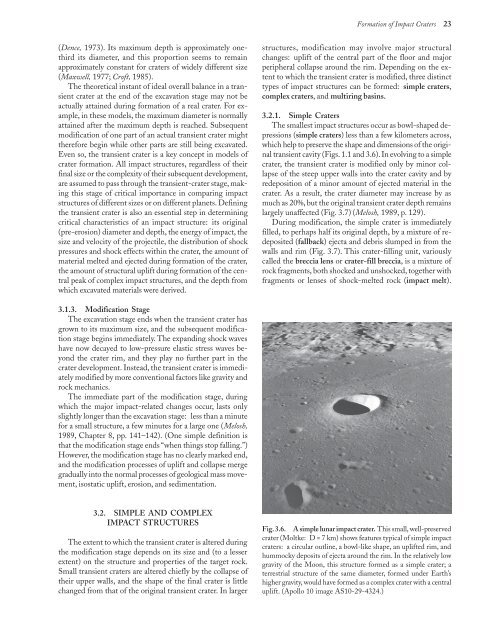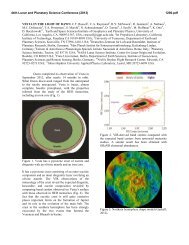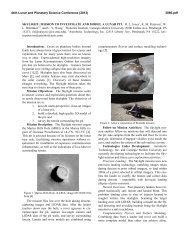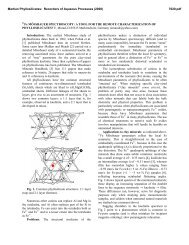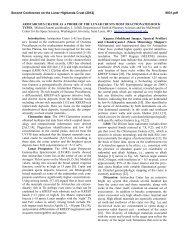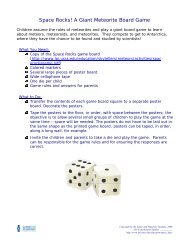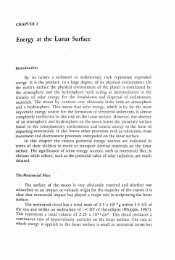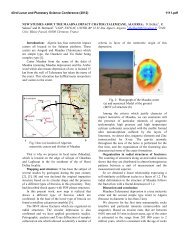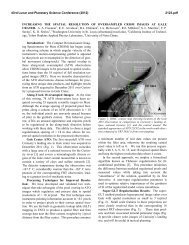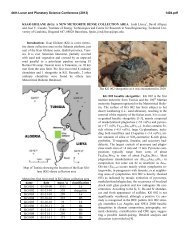Formation of Impact Craters - Lunar and Planetary Institute
Formation of Impact Craters - Lunar and Planetary Institute
Formation of Impact Craters - Lunar and Planetary Institute
Create successful ePaper yourself
Turn your PDF publications into a flip-book with our unique Google optimized e-Paper software.
(Dence, 1973). Its maximum depth is approximately onethird<br />
its diameter, <strong>and</strong> this proportion seems to remain<br />
approximately constant for craters <strong>of</strong> widely different size<br />
(Maxwell, 1977; Cr<strong>of</strong>t, 1985).<br />
The theoretical instant <strong>of</strong> ideal overall balance in a transient<br />
crater at the end <strong>of</strong> the excavation stage may not be<br />
actually attained during formation <strong>of</strong> a real crater. For example,<br />
in these models, the maximum diameter is normally<br />
attained after the maximum depth is reached. Subsequent<br />
modification <strong>of</strong> one part <strong>of</strong> an actual transient crater might<br />
therefore begin while other parts are still being excavated.<br />
Even so, the transient crater is a key concept in models <strong>of</strong><br />
crater formation. All impact structures, regardless <strong>of</strong> their<br />
final size or the complexity <strong>of</strong> their subsequent development,<br />
are assumed to pass through the transient-crater stage, making<br />
this stage <strong>of</strong> critical importance in comparing impact<br />
structures <strong>of</strong> different sizes or on different planets. Defining<br />
the transient crater is also an essential step in determining<br />
critical characteristics <strong>of</strong> an impact structure: its original<br />
(pre-erosion) diameter <strong>and</strong> depth, the energy <strong>of</strong> impact, the<br />
size <strong>and</strong> velocity <strong>of</strong> the projectile, the distribution <strong>of</strong> shock<br />
pressures <strong>and</strong> shock effects within the crater, the amount <strong>of</strong><br />
material melted <strong>and</strong> ejected during formation <strong>of</strong> the crater,<br />
the amount <strong>of</strong> structural uplift during formation <strong>of</strong> the central<br />
peak <strong>of</strong> complex impact structures, <strong>and</strong> the depth from<br />
which excavated materials were derived.<br />
3.1.3. Modification Stage<br />
The excavation stage ends when the transient crater has<br />
grown to its maximum size, <strong>and</strong> the subsequent modification<br />
stage begins immediately. The exp<strong>and</strong>ing shock waves<br />
have now decayed to low-pressure elastic stress waves beyond<br />
the crater rim, <strong>and</strong> they play no further part in the<br />
crater development. Instead, the transient crater is immediately<br />
modified by more conventional factors like gravity <strong>and</strong><br />
rock mechanics.<br />
The immediate part <strong>of</strong> the modification stage, during<br />
which the major impact-related changes occur, lasts only<br />
slightly longer than the excavation stage: less than a minute<br />
for a small structure, a few minutes for a large one (Melosh,<br />
1989, Chapter 8, pp. 141–142). (One simple definition is<br />
that the modification stage ends “when things stop falling.”)<br />
However, the modification stage has no clearly marked end,<br />
<strong>and</strong> the modification processes <strong>of</strong> uplift <strong>and</strong> collapse merge<br />
gradually into the normal processes <strong>of</strong> geological mass movement,<br />
isostatic uplift, erosion, <strong>and</strong> sedimentation.<br />
3.2. SIMPLE AND COMPLEX<br />
IMPACT STRUCTURES<br />
The extent to which the transient crater is altered during<br />
the modification stage depends on its size <strong>and</strong> (to a lesser<br />
extent) on the structure <strong>and</strong> properties <strong>of</strong> the target rock.<br />
Small transient craters are altered chiefly by the collapse <strong>of</strong><br />
their upper walls, <strong>and</strong> the shape <strong>of</strong> the final crater is little<br />
changed from that <strong>of</strong> the original transient crater. In larger<br />
<strong>Formation</strong> <strong>of</strong> <strong>Impact</strong> <strong>Craters</strong> 23<br />
structures, modification may involve major structural<br />
changes: uplift <strong>of</strong> the central part <strong>of</strong> the floor <strong>and</strong> major<br />
peripheral collapse around the rim. Depending on the extent<br />
to which the transient crater is modified, three distinct<br />
types <strong>of</strong> impact structures can be formed: simple craters,<br />
complex craters, <strong>and</strong> multiring basins.<br />
3.2.1. Simple <strong>Craters</strong><br />
The smallest impact structures occur as bowl-shaped depressions<br />
(simple craters) less than a few kilometers across,<br />
which help to preserve the shape <strong>and</strong> dimensions <strong>of</strong> the original<br />
transient cavity (Figs. 1.1 <strong>and</strong> 3.6). In evolving to a simple<br />
crater, the transient crater is modified only by minor collapse<br />
<strong>of</strong> the steep upper walls into the crater cavity <strong>and</strong> by<br />
redeposition <strong>of</strong> a minor amount <strong>of</strong> ejected material in the<br />
crater. As a result, the crater diameter may increase by as<br />
much as 20%, but the original transient crater depth remains<br />
largely unaffected (Fig. 3.7) (Melosh, 1989, p. 129).<br />
During modification, the simple crater is immediately<br />
filled, to perhaps half its original depth, by a mixture <strong>of</strong> redeposited<br />
(fallback) ejecta <strong>and</strong> debris slumped in from the<br />
walls <strong>and</strong> rim (Fig. 3.7). This crater-filling unit, variously<br />
called the breccia lens or crater-fill breccia, is a mixture <strong>of</strong><br />
rock fragments, both shocked <strong>and</strong> unshocked, together with<br />
fragments or lenses <strong>of</strong> shock-melted rock (impact melt).<br />
Fig. 3.6. A simple lunar impact crater. This small, well-preserved<br />
crater (Moltke: D = 7 km) shows features typical <strong>of</strong> simple impact<br />
craters: a circular outline, a bowl-like shape, an uplifted rim, <strong>and</strong><br />
hummocky deposits <strong>of</strong> ejecta around the rim. In the relatively low<br />
gravity <strong>of</strong> the Moon, this structure formed as a simple crater; a<br />
terrestrial structure <strong>of</strong> the same diameter, formed under Earth’s<br />
higher gravity, would have formed as a complex crater with a central<br />
uplift. (Apollo 10 image AS10-29-4324.)


